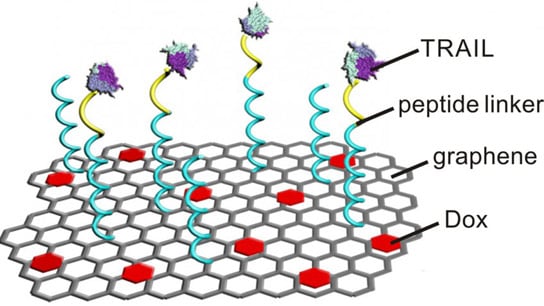
Using graphene strips to deliver anticancer drugs sequentially to cancer cells, researchers are able to target the distinct part of the cell where the drug will be most effective.
An international team of researchers has developed a drug delivery technique that utilizes graphene strips as “flying carpets” to deliver two anticancer drugs sequentially to cancer cells, with each drug targeting the distinct part of the cell where it will be most effective. The technique was found to perform better than either drug in isolation when tested in a mouse model targeting a human lung cancer tumor.
The researchers also found that an anticancer protein, TRAIL, can serve as an active targeting molecule to bind directly to the surface of cancer cells, which had not been demonstrated previously. The work was done by researchers at North Carolina State University, the University of North Carolina at Chapel Hill, and China Pharmaceutical University (CPU).
In this study, the researchers attached two drugs – TRAIL and doxorubicin (Dox) – onto graphene strips. Graphene is a two-dimensional sheet of carbon that is only one atom thick. Because TRAIL is most effective when delivered to the external membrane of a cancer cell, while Dox is most effective when delivered to the nucleus, the researchers wanted to deliver the drugs sequentially, with each drug hitting a cancer cell where it will do the most damage.
The Dox is physically bound to the graphene due to similarities in the molecular structure of the drug and the graphene. The TRAIL is bound to the surface of the graphene by a chain of amino acids called peptides.
“These drug-rich graphene strips are introduced into the bloodstream in solution, and then travel through the bloodstream like nanoscale flying carpets,” explains Dr. Zhen Gu, senior author of a paper describing the work and an assistant professor in the joint biomedical engineering program at NC State and UNC-Chapel Hill.
Once in the bloodstream, these flying carpets take advantage of the fact that cancer tumors cause nearby blood vessels to leak by using those leaks to penetrate into the tumor.
When the flying carpet comes into contact with a cancer cell, receptors on the surface of the cell latch onto the TRAIL. Meanwhile, enzymes that are common on the surface of cancer cells sever the peptides linking the TRAIL and the graphene. This allows the cell to absorb the Dox-laden graphene and leaves the TRAIL on the surface, where it begins a process to trigger cell death.
After the flying carpet is “swallowed” by the cell, the acidic environment inside the cell promotes the separation of the Dox from the graphene – freeing it to attack the nucleus.
“We’ve demonstrated that TRAIL itself can be used to attach a drug delivery system to a cancer cell, without using intervening material – which is something we didn’t know,” Gu says. “And because graphene has a large surface area, this technique enhances our ability to apply TRAIL to its target on cancer cell membranes.”
The researchers tested the flying carpet drug delivery technique in preclinical trials against human lung cancer tumors (cell line A549) in laboratory mice. The technique was significantly more effective than Dox or TRAIL by themselves, or to a combination of Dox and TRAIL in which the peptide link between the graphene and the TRAIL couldn’t be severed.
“We’re now trying to secure funding to support additional preclinical studies in order to determine how best to proceed with this new technique,” Gu says.
The paper, “Furin-Mediated Sequential Delivery of Anticancer Cytokine and Small-Molecule Drug Shuttled by Graphene,” was published in early view online December 15 in Advanced Materials. The lead author of the paper is Dr. Tianyue Jiang, a former graduate student in Gu’s lab who is now on the faculty at Nanjing Tech University. The co-corresponding author is Dr. Ran Mo, who is also a former postdoctoral researcher in Gu’s lab who is now on faculty at CPU. Co-authors include Wujin Sun, a Ph.D. student in Gu’s lab; Qiuwen Zhu, a Ph.D. student at CPU; Nancy Burns, a Ph.D. student at NC State; and Dr. Saad Khan, Alcoa Professor of Chemical and Biomolecular Engineering at NC State.
This research was supported by the North Carolina Translational and Clinical Sciences Institute under grant number 1UL1TR001111 and with funding from NC State and UNC-Chapel Hill.
Reference: “Furin-Mediated Sequential Delivery of Anticancer Cytokine and Small-Molecule Drug Shuttled by Graphene” by Tianyue Jiang, Wujin Sun, Qiuwen Zhu, Nancy A. Burns, Saad A. Khan, Ran Mo and Zhen Gu, 15 December 2014, Advanced Materials.
DOI: 10.1002/adma.201404498
1 Comment
How are the cells (or your overall body for that matter) supposed to dispose of the graphene? To my knowledge, this should create cancerous benzene rings that will float around your body, essentially voiding the anticancer medicine. If your body cannot adequately dispose of these sheets of graphene, they’ll accumulate as cellular debris that your body won’t know what to do with, causing a lot of cysts or other nasty things. Then you have the issue of these graphene strips of attaching onto non-cancerous cells, etc… This research just sounds like a bad idea to me.